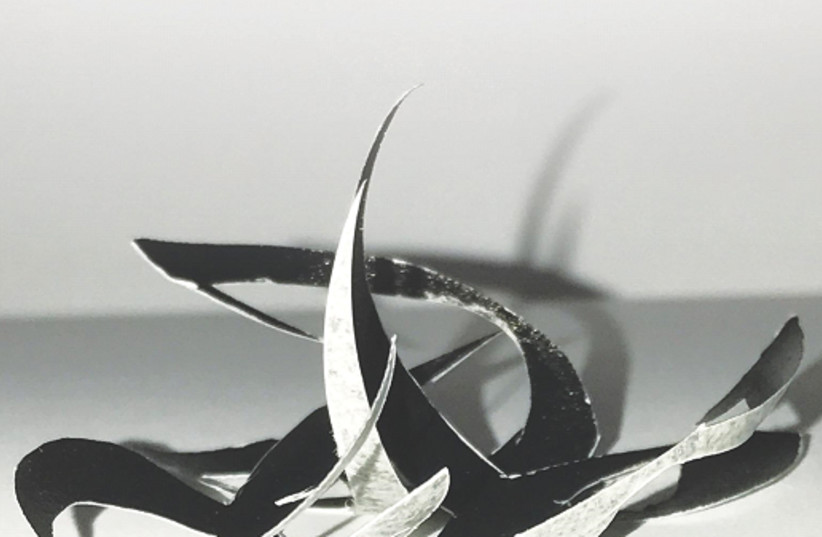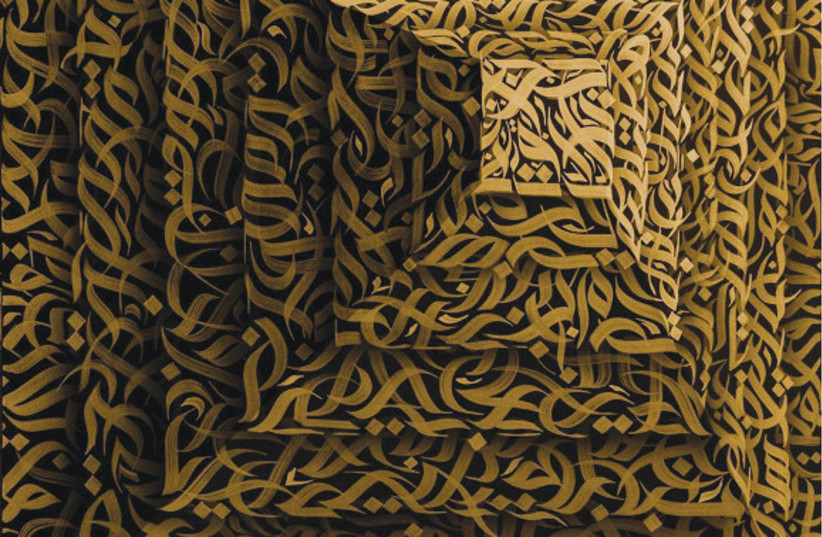As books cannot be judged by their cover, so too can art not be judged by first glance.
From afar, some visitors to the Jerusalem Theatre’s new unprecedented exhibit thought that some of the showpieces had Arabic calligraphy written across their canvases. Closer inspection of the art surprised them – it was Hebrew, written in an Arabic calligraphic style.
Challenging preconceived notions of division between Hebrew and Arabic is just one of the appeals, and purposes, of the “Maktoub” art project.
Maktoub, on exhibit at the Jerusalem Theatre from November 20 until December 30, is the first joint Israeli and Emirati grassroots art initiative in Israel. The exhibit features five artists from Israel and five from the United Arab Emirates, working on canvas with Hebrew and Arabic calligraphy.
Maktoub introduces Emirati art to Israeli audiences, exploring both the diversity within each state and the similarities between the two. One of these commonalities, and an intended point of bonding for the audiences, is the linguistic harmony and closeness between Hebrew and Arabic.
The exhibition was launched on November 20 with a closed event for artists, diplomats, governmental officials and cultural influencers. Attendees included Jerusalem Deputy Mayor Fleur Hassan Nahum, British Ambassador Neil Wigan and MK Amir Ohana. Guests enjoyed the exhibit while serenaded by a musician playing the Oud.
Maktoub was curated by artists Chama Mechtaly and Lenore Mizrachi-Cohen, who also contributed their own works alongside Diaa Allam, Said al-Nahari, David Goldstein, Itamar Heifetz, Izzy Pludwinski and Thoufeek Zakriya.
“As you can see in Maktoub, both the UAE and Israel count artists of various backgrounds, traditions and talents,” said Mechtaly. “Some of them grew up in a Jewish society and dedicated their artistic practice to Arabic calligraphy, and some of them grew up in a Muslim community, but they turned toward Hebrew calligraphy to express the plurality of their history and identity.”
Mechtaly is an Amazigh-Moroccan artist and activist who lives in the UAE. The CEO and founder of Dubai-based design company Moors & Saints, she lived in Morocco until she was 17, where the traces of a shared past between Jews and Muslims had been painted over with a broad brush of conflict.
Mechtaly’s father grew up in a Jewish neighborhood in Morocco, and her grandfather had Amazigh-Jewish roots. “Scratch a Moroccan, find a Berber – Scratch twice, a Jew,” said Mechtaly.
While the treatment of Jews in Morocco has been far from perfect, only the conflict has been focused on, and not the positive relationships.
At Brandeis University, Mechtaly was exposed to American Ashkenazi Jewish culture and values, including the concept of tikkun olam. She involved herself in a few initiatives to repair the rifts in the region, and while speaking and social media had their place, she eventually took her questions to the canvas.
MIZRACHI-COHEN reached out to Mechtaly with the idea for Maktoub following the signing of the Abraham Accords, the historic normalization agreement between Israel, the UAE and Bahrain, who were later joined by Morocco and Sudan. Mizrachi-Cohen is a Syrian-American Jew who now lives in Jerusalem. She is an experienced artist who has employed calligraphy, embroidery, collage, photography and light to explore themes of heritage and roots in contemporary life, a motif that has continued with Maktoub.
“Maktoub is a collaborative effort between artists who share a love of the written word,” said Mizrachi-Cohen. “Now that we are able to freely exchange our ideas, skills and values, what might we still achieve?”
The free exchange that began with the signing of the Abraham accords continued with the signing of canvas by Emirati and Israeli artists. The works in the exhibition are an “expression of the longing of both communities of both sides of the conflict,” said Mechtaly.
Activists had long been waiting to engage in grassroots development of relationships with Israel. While the written agreements allowed for unhindered interaction between the parties, according to Mechtaly political and economic overtures had to be complemented by “cultural entrepreneurship” that would expand “social and cultural understanding.”
Even if agreements failed, there would be a societal basis for peace, Mechtaly noted. It was her hope that projects like theirs would heal “the wounds of time through art.”
Those scars, though healing, were still fresh. “It was really impactful, people were in tears,” Mechtaly said of the opening event. According to Mechtaly, one of those people was Eliav Benjamin, Counselor for Political Affairs at the Israel Embassy in Washington, who was honored at the event for his crucial role in fostering the new regional relations. He was not alone in his appreciation for the event. A diplomat from an Abraham Accords country was impressed, and voiced that he wanted to replicate the project in his country.
British Ambassador Wigan, whose embassy helped sponsor the exhibit, made a televised speech at the opening reception, saying “Maktoub is a natural fit to be the first exhibition presenting collaborations between Israeli and Emirati artists, and that’s why we at the British Embassy are delighted to support it... Calligraphy and the written word have vital importance for Jewish and Islamic cultures and religions.”
“The goals of Maktoub align with our broader aim of encouraging increased cultural exchange between the city of Jerusalem and the people of the United Arab Emirates, as we believe it embodies the values of the friendship between our respective countries and will carry the message of tolerance and demonstrate our commitment to sustainable peace beyond the Middle East, impacting communities all over the world,” said Deputy Mayor Hassan Nahum.
LIKE THE art exhibited, the project had many contributors. It was launched as part of the Jerusalem Biennale, a multi-venue international contemporary art festival that occurs in the Holy City every two years. American philanthropists Jon and Dina Leader sponsored the event along with the British Embassy, and Israeli American consultant Eitan Charnoff organized the launch. The UAE culture ministry gave the event their blessing.
At first glance, the Israeli and Arab, and Jewish and Muslim relationships have been fraught with conflict. But with a closer look, afforded by the windows of canvas, the foundations for enduring peace can be seen – and built upon. Maktoub means “written” or “destined” in Arabic. What happens in the past informs the present, but the page can always be turned, and a new entry written.
“It is written that Jews and Muslims have shared our past and present in this region, but we pray we may write a future of peace and tolerance,” said Mechtaly.
Maktoub is open to the public, free of charge, in The Salon Gallery of The Jerusalem Theatre, through December 30. Hours: Sunday-Thursday 4:30 – 9 p.m.; Friday 10 a.m. – 2 p.m; Saturday from venue opening time till 9 p.m. The Jerusalem Theatre complex operates in accordance with the current Health Ministry guidelines.


